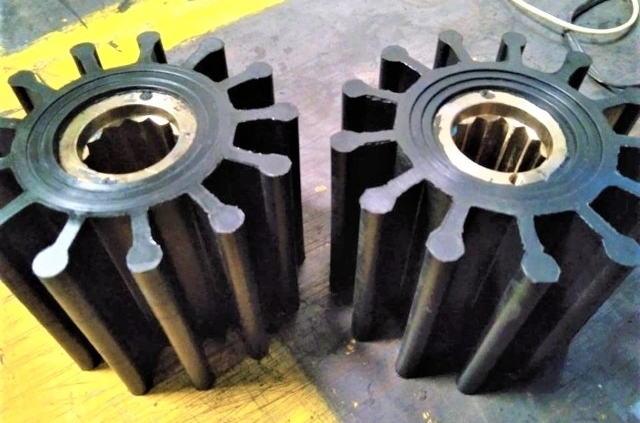Rubber Impeller
Rubber Impeller
Product Description
A rubber impeller is a high-speed rotating component from a pump or compressor that operates as a propeller to enhance the pressure and flow rate. Impellers can be built of iron, bronze, metal, rubber, silicone, and steel. As the fluid flows through the pump, the Impeller transmits energy to it, increasing the fluid’s velocity at the discharge outlet.
Types of Impeller
Open-type Impeller – is a type of Impeller used on a shaft near the wall. It’s stronger than closed impellers and slightly weaker than semi-closed impellers.
Semi-closed Type Impeller – are used to stir any mixture of solid particles and liquids. These impellers are generally less efficient than the closed impellers. However, they may be used to stir liquid mixtures, although they will lose efficiency when mixing the solids and liquids.
Closed-type Impeller – includes a vane and back wall on both sides of the vane, which extends the vane’s life and reduces the thrust load. The shaft costs less due to fewer parts and fewer assemblies.
To know more about rubber impellers and other customized rubber products. Kindly contact our sales team.
Features of Rubber Impeller
- Excellent resistance to corrosion; longer lifespan than an alloy or metal type impeller
- Significantly increase the pressure in pipe system due to its good traction.
- Has good resistance to UV, gasoline, fluids, chemicals, and more…
- Superior tear and wear resistance
- Very flexible and maintenance-free
- Can handle low and high temperature
- Made from high-grade compound materials
For Manufacturing, Servicing, and Supplying of rubber products, we only cover the entire Visayas and Mindanao Regions. For faster transactions, feel free to contact our sales team.
Globe: (+63)-916-444-0421 & Smart: (+63)-961-604-3588
Sales Office Location:
#63 F. Gochan Street Mabolo, Cebu City, Cebu Region 7, Philippines
Rubber Impeller
A rubber impeller is a high-speed rotating component from a pump or compressor that operates as a propeller to enhance the pressure and flow rate. Impellers can be built of iron, bronze, metal, rubber, silicone, and steel. As the fluid flows through the pump, the Impeller transmits energy to it, increasing the fluid’s velocity at the discharge outlet.
History
The first rubber impellers were developed in the early 1800s. They were made from vulcanized rubber, a type of rubber treated with sulfur to make it more durable. Charles Goodyear first developed vulcanized rubber in 1839. Rubber impellers were initially used in pumps and other machinery where they came into contact with moving parts. Using a rubber impeller over different materials, such as metal, is much less likely to damage the equipment.
The first recorded use of a rubber impeller was in 1844 when they were used in a steam engine designed by George Stephenson. Rubber impellers continued to be used in steam engines for many years until more efficient designs replaced them. Between the 19th & 20th centuries, rubber was used in many products. This included rubber boots, tires, hoses, and other products that are still commonly used today.
Different Applications
Rubber impellers are one of the world’s most versatile and widely used products. They have a wide variety of applications, from personal to industrial. Here are just a few of the different ways rubber impellers can be used:
- Personal hygiene products like toothbrushes and hairbrushes;
- In medical devices like blood pressure monitors and stethoscopes;
- Swimming pool pumps are typically designed to operate at lower speeds than other pumps, so smaller motors can power them. This makes them more energy-efficient and less likely to overheat.
- Sewage treatment plants use rubber impellers to move sludge and other solids through the treatment process.
- Irrigation systems use rubber impellers to pump water from wells or other sources and deliver it to crops or other areas where it is needed.
Types of Impeller
- Open-type Impeller – is a type of Impeller used on a shaft near the wall. It’s stronger than closed impellers and slightly weaker than semi-closed impellers.
- Semi-closed Type Impeller – are used to stir any mixture of solid particles and liquids. These impellers are generally less efficient than closed impellers. However, they may be used to stir liquid mixtures, although they will lose efficiency when mixing the solids and liquids.
- Closed-type Impeller – includes a vane and back wall on both sides of the vane, which extends the vane’s life and reduces the thrust load. The shaft costs less due to fewer parts and fewer assemblies.
Which to choose for the impeller?
There are many factors to consider when choosing an impeller for a given application. The three most common materials for impellers are alloys, metals, and rubbers. Each has its advantages and disadvantages that must be considered. In general, alloys are the best choice for high-pressure applications, while metals are better suited for low-pressure applications. Rubbers are typically used in applications where corrosion resistance is required.
Tips for using a rubber impeller
- Make sure the impeller is installed correctly before use.
- Check the condition of the impeller regularly.
- Be careful when handling the impeller, as it can be damaged easily.
- Keep the impeller clean to prevent clogging.
- Turn the machine off before replacing the impeller.
Features of Rubber Impeller
- Excellent resistance to corrosion; longer lifespan than an alloy or metal-type impeller
- Significantly increase the pressure in the pipe system due to its good traction.
- Good resistance to UV, gasoline, fluids, chemicals, and more…
- Superior tear and wear resistance
- Very flexible and maintenance-free
- Can handle low and high temperature
- Made from high-grade compound materials
To know more about rubber impellers and other customized rubber products. Kindly contact our sales team.
Actual Product
Dimensions may vary depending on the specifications

